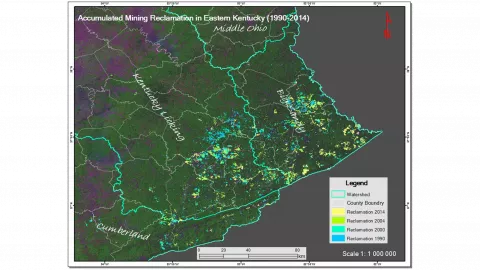Forest Health and Ecological Restoration
Forest Health and Ecological Restoration
Understanding the Role of Fire in Upland Hardwood Forests

A McIntire-Stennis supported project
Managers responsible for maintaining the diversity and productivity of central and southern Appalachian forests are increasingly turning to fire as one of several valuable tools for managing upland oak-dominated forests. McIntire-Stennis supported research at the University of Kentucky Department of Forestry and Natural Resources has helped to pioneer our understanding of the multifaceted roles of fire in this region by examining forest response to repeated prescribed fire, the combined use of prescribed fire and other practices in oak woodland restoration, and the impacts of accidental wildfire.
Results from 25 years of research point to the importance of using repeated fire followed by a fire-free interval to allow oak regeneration to establish and grow into saplings that are necessary to maintain oak in future forests and that excluding fire can lead, over time, to an increase in competing tree species that can limit oak regeneration. Research has also informed landowners and managers on the challenges of managing sites burned by wildfire.
Collaboration
This research is a long-term collaboration between researchers at the University of Kentucky, Department of Forestry and Natural Resources, USDA Forest Service Daniel Boone National Forest and Bent Creek Experimental Forest, aided by resources from the USDA-USDI Joint Fire Science Program.
Impact
This research has informed forest management approaches to the use of fire throughout the central and Appalachian hardwood forest regions by addressing underlying ecological implications of fire, and the absence of fire, as disturbance agents applied to forest ecosystems where fire was used for millennia by Native peoples before being restricted for the past century.
12,350+ and 100+
The number of graduate students, undergraduate students, and professional foresters trained in science-based understanding of the role of fire in central and Appalachian hardwood.
Leading
the region for 25 years in implementation of ongoing research on the use of prescribed fire in oak dominated upland forests used in management of public and private forests.
About McIntire-Stennis
The McIntire-Stennis program, a unique federal-state partnership, cultivates and delivers forestry and natural resource innovations for a better future. By advancing research and education that increases the understanding of emerging challenges and fosters the development of relevant solutions, the McIntire-Stennis program has ensured healthy resilient forests and communities and an exceptional natural resources workforce since 1962
Additional Research

Integration of landscape ecology and ecosystem service assessment for spatially-explicit appraisal of surface mining reclamation benefits in eastern Kentucky
Surface mining has impacted a large portion (> 10,000 ha) of eastern Kentucky’s land. These lands are important parts of the Appalachian forest landscape, providing invaluable ecological goods and services (EGS) to the human society. It has been reported that surface mining can inflict dire environmental consequences ranging from soil degradation to water pollution and biodiversity loss, and such negative influences may persist for a long time if without proper mining reclamation.
Restoration of degraded mine land to forest, although ideal, often finds difficult to implement at large scales. This is partially due to limited resources and techniques, but also partially due to our limited cost-benefit analysis that hinders the willingness of various stakeholders and policymakers to commit the due capital to this process.
Studies have begun to employ ecosystem service assessment as a framework to analyze the benefits of surface mining reclamation. However, such studies often conduct the assessment at the individual mining site level, and lack the consideration of the spatial heterogeneity and dynamics of the ecological, social, and economical processes at large scales where numerous abandoned mining sites need to be collectively considered.
In this research, we propose to integrate landscape ecology into ecosystem service assessment to address the interactions between patterns and processes at large spatial and broad temporal scales. We employ remote sensing and GIS to map the dynamics of mining and reclamation activities over a three-decade time span, and develop new approaches to take consideration of scaling effects when assessing ecosystem services spatially explicitly with the InVEST model.
Our end research products (ecosystem services assessment maps under different working scenarios) can provide a more comprehensive appraisal of the benefits and trade-offs for various reclamation strategies. Moreover, we envision this study can help to identify hotspots for reclamation and assist the decision making process for allocating the limited resources at landscape scales.
Associated Faculty
Research Topic Areas
Research Quick Links
Forestry and Natural Resources Department
forestry.department@uky.edu
(859) 257-7596
Forestry and Natural Resources Extension
forestry.extension@uky.edu
(859) 257-7597
